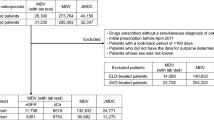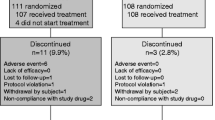Abstract
Introduction
Eldecalcitol (ELD) is an active vitamin D3 analog (AVD) commonly used to treat osteoporosis in Japan. Although routine monitoring of serum calcium levels during ELD therapy is recommended, little is known about the actual frequency and determinants of monitoring.
Materials and methods
This was a descriptive cohort study using a Japanese electronic medical records database. We identified osteoporosis patients who initiated treatment with ELD or other AVDs (alfacalcidol and calcitriol) between April 1, 2011 and September 10, 2021. The index date for cohort entry was the first prescription date of ELD or other AVDs. The frequency of serum calcium monitoring was evaluated every 6 months. Determinants of serum calcium monitoring were identified using multivariable logistic regression models. We also calculated the incidence of hypercalcemia and the frequency of serum calcium monitoring within 6 months before hypercalcemia.
Results
We identified 12,671 ELD users and 7867 other AVD users. Within 6 months after cohort entry, 45.9% of ELD users and 58.7% of other AVD users underwent serum calcium monitoring. Female sex, no use of systemic corticosteroids, moderate-to-good renal function, treatment in smaller hospitals, and treatment in orthopedic surgery departments were associated with a lower likelihood of receiving serum calcium monitoring during ELD therapy. The incidence of hypercalcemia among ELD users was 6.36 per 100 person-years, with 20.6% of cases not receiving serum calcium monitoring before hypercalcemia.
Conclusion
Our findings suggest that serum calcium monitoring is not given adequate attention during ELD therapy in routine clinical practice.


Similar content being viewed by others
References
Cui L, Xia W, Yu C, Dong S, Pei Y (2022) Overview of the clinical efficacy and safety of eldecalcitol for the treatment of osteoporosis. Arch Osteoporos 17:74
Fujiwara S, Miyauchi A, Hamaya E, Nicholls RJ, Weston A, Baidya S, Pinto L, Barron R, Takada J (2018) Treatment patterns in patients with osteoporosis at high risk of fracture in Japan: retrospective chart review. Arch Osteoporos 13:34
Noguchi Y, Kawate H, Nomura M, Takayanagi R (2013) Eldecalcitol for the treatment of osteoporosis. Clin Interv Aging 8:1313–1321
Matsumoto T, Ito M, Hayashi Y, Hirota T, Tanigawara Y, Sone T, Fukunaga M, Shiraki M, Nakamura T (2011) A new active vitamin D3 analog, eldecalcitol, prevents the risk of osteoporotic fractures–a randomized, active comparator, double-blind study. Bone 49:605–612
Xu Z, Fan C, Zhao X, Tao H (2016) Treatment of osteoporosis with eldecalcitol, a new vitamin D analog: a comprehensive review and meta-analysis of randomized clinical trials. Drug Des Devel Ther 10:509–517
Aihara S, Yamada S, Oka H, Kamimura T, Nakano T, Tsuruya K, Harada A (2019) Hypercalcemia and acute kidney injury induced by eldecalcitol in patients with osteoporosis: a case series of 32 patients at a single facility. Ren Fail 41:88–97
Walker MD, Shane E (2022) Hypercalcemia: a review. JAMA 328:1624–1636
Saito H, Kakihata H, Nishida Y, Yatomi S, Nihojima S, Kobayashi Y, Tabata H, Nomura M (2017) The safety and effectiveness profile of eldecalcitol in a prospective, post-marketing observational study in Japanese patients with osteoporosis: interim report. J Bone Miner Metab 35:456–463
Takeuchi Y, Saito H, Makishima M, Yokoyama H, Yamaguchi T, Fujii H, Inoue E, Isemura T, Kondo S, (2022) Long-term safety of eldecalcitol in Japanese patients with osteoporosis: a retrospective, large-scale database study. J Bone Miner Metab 275–291
Pharmaceuticals and Medical Devices Agency alert for proper use of drugs. Hypercalcemia induced by eldecalcitol and compliance with laboratory testing. Available: https://www.pmda.go.jp/files/000237333.pdf. Accessed Jan, 2023.
Pharmacoepidemiology & Database Taskforce, Japanese Society for Pharmacoepidemiology. Survey of Japanese databases in Japan available for clinical/pharmacoepidemiology. Available: http://www.jspe.jp/committee/020/0210/. Accessed Jan, 2023.
Ri K, Fukasawa T, Yoshida S, Takeuchi M, Kawakami K (2023) Risk of parkinsonism and related movement disorders with gabapentinoids or tramadol: A case-crossover study. Pharmacotherapy 43:136–144
Yoshida S, Takeuchi M, Tanaka-Mizuno S, Mizuno K, Nakashima M, Fukasawa T, Kawakami K (2022) Clinical epidemiology and pharmacoepidemiology studies with real-world databases. Proceedings of the Japan Academy, Series B 98:517–528
Hashimoto H, Takeuchi M, Kawakami K (2022) Association between biopsies for anti-neutrophil cytoplasmic antibody-associated vasculitis and prognosis: a retrospective cohort study. Clin Rheumatol 41:541–548
Usui T, Funagoshi M, Seto K, Ide K, Tanaka S, Kawakami K (2018) Persistence of and switches from teriparatide treatment among women and men with osteoporosis in the real world: a claims database analysis. Arch Osteoporos 13:54
Lyu H, Yoshida K, Zhao SS, Wei J, Zeng C, Tedeschi SK, Leder BZ, Lei G, Tang P, Solomon DH (2020) Delayed Denosumab injections and fracture risk among patients with osteoporosis. Ann Intern Med 173:516–526
Austin PC (2009) Balance diagnostics for comparing the distribution of baseline covariates between treatment groups in propensity-score matched samples. Stat Med 28:3083–3107
Mulla ZD, Seo B, Kalamegham R, Nuwayhid BS (2009) Multiple imputation for missing laboratory data: an example from infectious disease epidemiology. Ann Epidemiol 19:908–914
Sterne JAC, White IR, Carlin JB, Spratt M, Royston P, Kenward MG, Wood AM, Carpenter JR (2009) Multiple imputation for missing data in epidemiological and clinical research: potential and pitfalls. BMJ 338:b2393
National Kidney Foundation (2003) K/DOQI clinical practice guidelines for bone metabolism and disease in chronic kidney disease. Am J Kidney Dis 42:S1-201
Jean G, Souberbielle JC, Chazot C (2017) Vitamin D in chronic kidney disease and dialysis patients. Nutrients 9:328
Kidney Disease: Improving Global Outcomes (KDIGO) CKD-MBD Update Work Group (2017) KDIGO 2017 clinical practice guideline update for the diagnosis, evaluation, prevention, and treatment of chronic kidney disease-mineral and bone disorder (CKD-MBD). Kidney Int Suppl 7:1–59
Deng Y-L, Hsu C-S, Hsu C-Y, Chen C-H, Ou S-F, Liu C-F, Yang S-H, Shih C-H, Chen Y-M, Lee H-T (2022) Predictors for self-discontinuation of anti-osteoporosis medication: a hospital-based real-world study. PLoS ONE 17:e0275020
Dennis MW (2018) Clinical pharmacology of corticosteroids. Respir Care 63:655
Acknowledgements
The authors are grateful to Dr. Guy Harris of Dmed (< www.dmed.co.jp >) for his support with the writing of the manuscript. This research was not supported by any specific grant from funding agencies in the public, commercial, or not-for-profit sectors.
Author information
Authors and Affiliations
Contributions
All authors were involved in formulating the study concept and design. KR performed the statistical analysis. KR and TF wrote the manuscript. All authors contributed to the discussion and reviewed, edited, and approved the final manuscript as submitted.
Corresponding author
Ethics declarations
Conflict of interest
Toshiki Fukasawa has been employed by the Department of Digital Health and Epidemiology, an Industry-Academia Collaboration Course supported by Eisai Co., Ltd., Kyowa Kirin Co., Ltd., and Real World Data Co., Ltd.; and has received consulting fees from Real World Data Co., Ltd. and speaker fees from Asahi Kasei Pharma Corporation and EPS Corporation. Shiro Tanaka has received lecture fees from Bayer Yakuhin, Amgen Astellas BioPharma K.K. and Research Institute of Healthcare Data Science; consulting fees from Boehringer Ingelheim; outsourcing fees from the Public Health Research Foundation; grants from Novo Nordisk Pharma Ltd., the Japan Agency for Medical Research and Development, the Japanese Ministry of Health Labor and Welfare, and the Japanese Ministry of Education, Science, and Technology. Masato Takeuchi has received consulting fees from Eisai Co., Ltd. Satomi Yoshida was employed by the Department of Digital Health and Epidemiology, an Industry-Academia Collaboration Course supported by Eisai Co., Ltd., Kyowa Kirin Co., Ltd., and Real World Data Co., Ltd.; and has received consulting fees from Real World Data Co., Ltd. Koji Kawakami has received research funds from Eisai Co., Ltd., Kyowa Kirin Co., Ltd., OMRON Corporation, Toppan Inc., and Real World Data Co., Ltd.; consulting fees from Advanced Medical Care Inc., JMDC Inc., and Shin Nippon Biomedical Laboratories Ltd.; executive compensation from Cancer Intelligence Care Systems, Inc.; honoraria from Chugai Pharmaceutical Co., Ltd., and Pharma Business Academy; and has held stock in Real World Data Co., Ltd. All other authors declare no potential conflicts of interest.
Additional information
Publisher's Note
Springer Nature remains neutral with regard to jurisdictional claims in published maps and institutional affiliations.
Supplementary Information
Below is the link to the electronic supplementary material.
About this article
Cite this article
Ri, K., Fukasawa, T., Masuda, S. et al. Frequency and determinants of serum calcium monitoring during eldecalcitol therapy in patients with osteoporosis. J Bone Miner Metab 41, 890–900 (2023). https://doi.org/10.1007/s00774-023-01470-7
Received:
Accepted:
Published:
Issue Date:
DOI: https://doi.org/10.1007/s00774-023-01470-7




